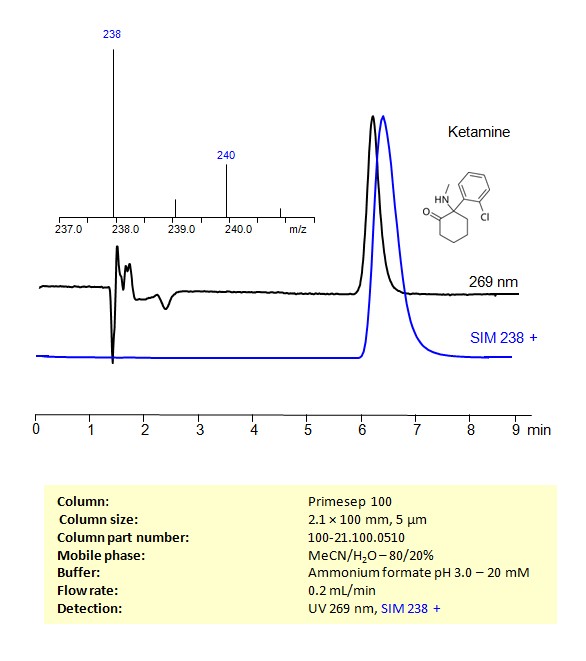HPLC Method for Analysis of Ketamine on Primesep 100 by SIELC Technologies

High Performance Liquid Chromatography (HPLC) Method for Analysis of Ketamine
Ketamine is a medication primarily used for induction and maintenance of anesthesia. It also has analgesic and sedative properties.
Ketamine is classified as an arylcyclohexylamine. Chemically, it is known as (RS)-2-(2-chlorophenyl)-2-(methylamino)cyclohexanone.
Ketamine is used primarily as an anesthetic and analgesic in both human and veterinary medicine. It has a unique mechanism of action, acting primarily as an antagonist of the N-methyl-D-aspartate (NMDA) receptor, which is involved in pain transmission and synaptic plasticity.
Beyond its primary medical use, ketamine has also been investigated for its rapid-acting antidepressant effects and is used in certain treatment-resistant cases of depression.
Due to its potential for misuse and the hallucinogenic effects it can produce at sub-anesthetic doses, ketamine is also classified as a controlled substance in many countries.
Ketamine can be retained, and analyzed on a Primesep 100 mixed-mode stationary phase column using an isocratic analytical method with a simple mobile phase of water, Acetonitrile (MeCN), and a ammonium format as a buffer. This analysis method can be detected using UV at 269 nm, an Evaporative Light Scattering Detector (ELSD), or any other evaporative detection method (CAD, ESI-MS)
| Column | Primesep 100, 2.1 x 100 mm, 5 µm, 100 A, dual ended |
| Mobile Phase | MeCN – 80%, |
| Buffer | Ammonium Formate pH 3.0-20 mM |
| Flow Rate | 0.2 ml/min |
| Detection | UV, 269 nm, SIM 238 + |
| Spray Voltage: | 1.5 kV |
| Nebulizing gas: | 1.5 L/min |
| Drying gas: | 15 L/min |
| DL temp: | 250 ˚C |
| Heat Block: | 400 ˚C |
| Class of Compounds | Drug, arylcyclohexylamine |
| Analyzing Compounds | Ketamine |
Application Column
Primesep 100
Column Diameter: 2.1 mm
Column Length: 100 mm
Particle Size: 5 µm
Pore Size: 100 A
Column options: dual ended





